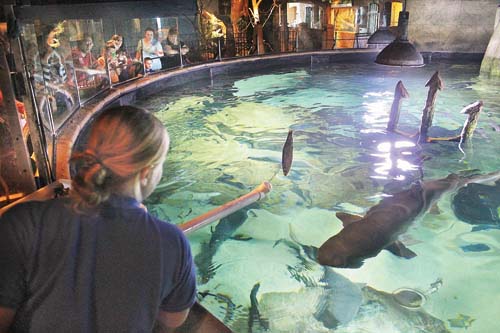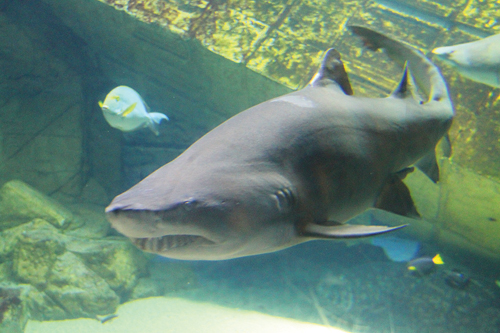It’s always shark week at Long Island Aquarium

As the seven-foot-long sand tiger shark glides through the water, it brushes against the glass of Long Island Aquarium’s huge 120,000-gallon tank. For most visitors, that encounter is close enough.
But some would like to get closer, much closer, and the aquarium is only too happy to oblige.
The aquarium’s shark diving program — open to any and all brave enough to enter a steel cage and spend half an hour with a trained diver as sharks circle around — is now in its fifth year.
The aquarium is also set to open a new “shark keeper” program on July 1, allowing guests to feed the sand tiger sharks, tour the facilities and bring home a shark’s tooth.
The sharks are at the top rung of the food chain in the “Lost City of Atlantis” exhibit, the aquarium’s largest.
The tank is home to two species of shark; five jagged-toothed sand tiger sharks caught off Jones Beach Inlet in 1999 and the more docile nurse sharks that prefer to rest on the bottom of the tank, said aquarist Maggie Seiler.
The diving program follows no set schedule. When someone calls and asks to swim with the sharks, the aquarium sets up a time.
Divers take a quick safety class in the morning, then return to the tank later in the day to don a special diving mask and a wet suit to keep them warm, Ms. Seiler said.
The mask is specially designed for use by amateurs and isn’t prone to problems that can befall standard scuba masks, such as water leaking inside. The masks also feature communication systems that allow divers to speak with the trainers and fellow divers.
“These things are great,” Ms. Seiler said, holding the black plastic mask in her hand.

Up to three guests can fit inside the cage, along with the aquarium’s professional diver. After the cage is lowered to the bottom of the tank, guests spend 30 minutes learning about the sharks that swim by.
Ms. Seiler said the sharks occasionally swim past the cage to see what’s inside.
The sand tiger sharks may appear especially frightening, but they wouldn’t want to make a meal out of a visitor, Ms. Seiler said. They’re simply too well fed.
“They get fed two, maybe three times a week,” she said. “During the week they’ll get five to seven pounds of food per shark. That’s very well fed for a shark. In the wild, naturally, these guys would be lucky to see food once a week.”
That’s why the sharks rarely attack the tank’s other fish.
And despite what “Jaws” might show, sharks don’t purposely feed on humans in the wild, she said.
Shark attacks are almost always the result of a shark mistaking a human for easy smaller prey, like an injured seal, she said.
“Let’s face it,” she said. “In the water, we’re not really graceful.”
Once a shark realizes its victim is not a seal, it generally swims away, she said, adding that shark attacks are actually quite rare.
“Getting in the car every day is more dangerous than going and taking a swim at the beach,” Ms. Seiler said. “There are so many more things you should be cautious and fearful about than getting bitten by a shark.”
The aquarium’s new program will also let visitors help feed the creatures. The sharks find the food, usually a dead fish, on prongs at the end of a PVC pole. An aquarist dangles the fish in front of the shark’s mouth, often tracking its movement until the shark takes a bite.
Ms. Seiler said people taking part in the dives often are afraid of the sharks at first but learn to conquer that fear.
That, she said, is the most rewarding part of her job.
“That’s always a lot of fun for me, being that person who exposed them to something new,” she said. “At the end of the dive they love it. You get to get close and have that experience, while staying safe.”
For more information on the shark diving and feeding programs, contact the Long Island Aquarium at 631-208-9200, ext. 426.


